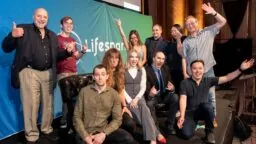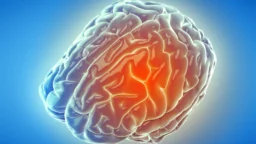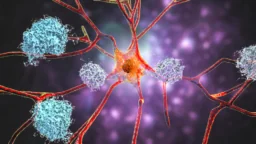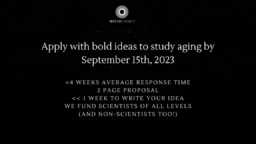EARD2023, the Longevity + DeSci Summit, is over, but the work its speakers have been doing continues. Here’s what’s happened on the aging research front in August.
LEAF News
Team and activities
 Science and Advocacy at the Longevity + DeSci Summit: After three years in digital format due to COVID concerns, one of the oldest longevity conferences was again welcoming attendants in New York City: Ending Age-Related Diseases (EARD), organized by Lifespan.io for the sixth time.
Science and Advocacy at the Longevity + DeSci Summit: After three years in digital format due to COVID concerns, one of the oldest longevity conferences was again welcoming attendants in New York City: Ending Age-Related Diseases (EARD), organized by Lifespan.io for the sixth time.
Lifespan News
Preventing Disease with AI: Emmett Short talks about what can be done to modify the healthcare system in ways that focus on preventing, rather than reacting to, disease.
 When Should You Die?: Ryan O’Shea talks about a real-world doctor whose euthanasia-related statements parallel those found in a particular episode of Star Trek.
When Should You Die?: Ryan O’Shea talks about a real-world doctor whose euthanasia-related statements parallel those found in a particular episode of Star Trek.
Advocacy and Analysis
Is Immortality Possible or Is Aging Inevitable?: “Could humans become immortal?” is something we get asked quite often, and the answer depends on what exactly you mean. Whether human immortality is possible greatly depends on how you define it.
Research Roundup
 Heterochronic Parabiosis Extends the Lives of Mice: For the first time, scientists have shown that letting young and old mice share blood leads to a significant lifespan extension in the old mouse.
Heterochronic Parabiosis Extends the Lives of Mice: For the first time, scientists have shown that letting young and old mice share blood leads to a significant lifespan extension in the old mouse.
Impact of Vitamin D Supplements on Mortality Risk: In a new study published in Nutrients, researchers analyzed the results of 80 randomized clinical trials and assessed the impact of vitamin D supplementation on mortality.
 Impaired Calcium Uptake May Impact Long-Term Inflammation: Scientists have reported in Nature Aging that impaired mitochondrial uptake of calcium ions leads to changes in inflammatory responses that resemble what happens in aging.
Impaired Calcium Uptake May Impact Long-Term Inflammation: Scientists have reported in Nature Aging that impaired mitochondrial uptake of calcium ions leads to changes in inflammatory responses that resemble what happens in aging.
The Flavonoid Rutin May Suppress Senescent Cells: Researchers publishing in Aging Cell have documented some potential effects of rutin against senescence and cancer. Rutin is a natural compound found in several plants.
 Analysis: Isometric Exercises Are Best for Blood Pressure: In a new expansive meta-analysis comparing several types of exercise, isometric exercises, which include wall squats and planks, were linked to the biggest decrease in blood pressure. As is very well-known, exercise confers numerous health benefits, including age-related benefits, and it has been linked to lower cardiovascular and cancer risks.
Analysis: Isometric Exercises Are Best for Blood Pressure: In a new expansive meta-analysis comparing several types of exercise, isometric exercises, which include wall squats and planks, were linked to the biggest decrease in blood pressure. As is very well-known, exercise confers numerous health benefits, including age-related benefits, and it has been linked to lower cardiovascular and cancer risks.
A Strong Correlation Between Happiness and Lifespan: Researchers publishing in BMC Geriatrics have found that people who reported being happy were considerably more likely to live longer than people who were not. The relationship between happiness and health, even controlling for other relevant factors, has been frequently confirmed and occasionally denied in the research.
 The Inflammatory Pathway to Brain Damage: Scientists publishing in Nature have explained a key pathway that leads to immune dysfunction and neurodegeneration in aging. Throughout this paper, the researchers cite other papers demonstrating a cause-and-effect relationship between initial damage and long-term effects.
The Inflammatory Pathway to Brain Damage: Scientists publishing in Nature have explained a key pathway that leads to immune dysfunction and neurodegeneration in aging. Throughout this paper, the researchers cite other papers demonstrating a cause-and-effect relationship between initial damage and long-term effects.
Artificial Sweeteners Associated with Fat, Weight Gain: A longitudinal analysis of a large cohort suggests an association between artificial sweetener intake and several markers of adiposity, such as visceral fat. Artificial sweeteners were invented to provide a healthier alternative to sugar and other high-calorie sweeteners, especially in the wake of the obesity epidemic.
 Liquid Metal Nanoparticles Eradicate Colon Cancer in Mice: Scientists have combined gallium nanoparticles with immunotherapy agents to deliver a decisive blow to colon cancer tumors in mice. Gallium is a metal that becomes liquid well below body temperature.
Liquid Metal Nanoparticles Eradicate Colon Cancer in Mice: Scientists have combined gallium nanoparticles with immunotherapy agents to deliver a decisive blow to colon cancer tumors in mice. Gallium is a metal that becomes liquid well below body temperature.
New Senolytics from Artificial Intelligence: Recent research published in Nature Communications has used machine learning algorithms to find senolytics, molecules that destroy senescent cells. Only a small number of such molecules have been identified, and only two have shown efficacy in clinical trials.
 Inflammation as a Biomarker of Mortality: In a paper published in Geroscience, researchers have developed a metric of systemic inflammation and used it to estimate mortality, finding that it performs better than epigenetic clocks.
Inflammation as a Biomarker of Mortality: In a paper published in Geroscience, researchers have developed a metric of systemic inflammation and used it to estimate mortality, finding that it performs better than epigenetic clocks.
Study: Vegetarians Have Higher Risk of Hip Fracture: Studying a large British cohort, scientists have found that vegetarians have an increased risk of hip fracture compared to regular meat eaters, but pescatarians and occasional meat eaters do not.
 Restoring Helper Cell Function to Fight Alzheimer’s: In a study published in Cell Stem Cell, researchers have investigated a way to repopulate the brain with functional cells in order to fight back against Alzheimer’s disease. This method was found to be functional in mice.
Restoring Helper Cell Function to Fight Alzheimer’s: In a study published in Cell Stem Cell, researchers have investigated a way to repopulate the brain with functional cells in order to fight back against Alzheimer’s disease. This method was found to be functional in mice.
Extracellular Vesicles from Stem Cells Reverse Senescence: Scientists have found that bubbles secreted by embryonic stem cells counter cellular senescence, in large part due to just two tiny snippets of RNA. Extracellular vesicles (EVs) are membrane-bound tiny bubbles that are loaded with various molecular cargo, such as proteins, DNA, or RNA, that cells secrete as a method of intercellular communication.
 Flavonoid Consumption Correlates With Less Biological Aging: Researchers investigated how much the consumption of flavonoids impacts the biological age of the heart, kidney, liver, and whole body. Flavonoids possess many beneficial properties, and previous research has found them to protect from oxidation, inflammation, mutagens, and carcinogens.
Flavonoid Consumption Correlates With Less Biological Aging: Researchers investigated how much the consumption of flavonoids impacts the biological age of the heart, kidney, liver, and whole body. Flavonoids possess many beneficial properties, and previous research has found them to protect from oxidation, inflammation, mutagens, and carcinogens.
Biomarker Study Returns Surprising Results: Researchers publishing in Biogerontology have tested multiple biomarkers in an effort to use them as proxies for aging, and some of their findings were surprising. Unlike other association studies that are used to evaluate biomarkers of aging, this study did not use data from a pre-existing biobank.
 Antioxidants Rescue Cognitive Decline in Mice: Scientists have found that EGCG and curcumin, two well-known antioxidants, are effective both alone and especially in combination in a mouse model of cognitive decline induced by oxidative stress.
Antioxidants Rescue Cognitive Decline in Mice: Scientists have found that EGCG and curcumin, two well-known antioxidants, are effective both alone and especially in combination in a mouse model of cognitive decline induced by oxidative stress.
Figuring Out Why Stem Cells Won’t Build Bone: Researchers publishing in Aging have uncovered some of the molecular mechanisms behind why mesenchymal stem cells (MSCs) do and don’t differentiate into bone-building osteoblasts, unlocking a potential new approach to osteoporosis.
 A Protective Mechanism Against AMD: A paper published in Aging explains the relationship of long noncoding RNAs, which change with aging, to age-related macular degeneration (AMD). AMD is the most common cause of vision loss in people over 70 years old.
A Protective Mechanism Against AMD: A paper published in Aging explains the relationship of long noncoding RNAs, which change with aging, to age-related macular degeneration (AMD). AMD is the most common cause of vision loss in people over 70 years old.
How Spaceflight Alters the Rate of Aging: A review published in Aging Cell has explored the impact of spaceflight on human and other organisms’ health and aging. This includes such things as circadian rhythms and gravity.
 Utilizing One of the Naked Mole Rat’s Abilities: Publishing in Nature, a team of researchers including Vadim Gladyshev, Steve Horvath, and Vera Gorbunova has investigated the role of hyaluronan, which naked mole rats have in abundance, as a protective mechanism in a mouse model.
Utilizing One of the Naked Mole Rat’s Abilities: Publishing in Nature, a team of researchers including Vadim Gladyshev, Steve Horvath, and Vera Gorbunova has investigated the role of hyaluronan, which naked mole rats have in abundance, as a protective mechanism in a mouse model.
Diversity in Daily Activities Might Slow Cognitive Decline: A new study suggests that greater diversity of everyday activities is associated with a slower rate of age-related cognitive decline, independently of the amount of physical activity.
 Treating Enlarged Hearts in Cats with Rapamycin: Researchers publishing in Journal of the American Veterinary Medical Association have conducted a feline clinical trial finding that rapamycin is effective against heart enlargement in cats.
Treating Enlarged Hearts in Cats with Rapamycin: Researchers publishing in Journal of the American Veterinary Medical Association have conducted a feline clinical trial finding that rapamycin is effective against heart enlargement in cats.
Senolytics Have Sex-Dependent Effects on Young Mice: In a research paper published in GeroScience, researchers investigated the impact of senolytics on young mice and found some surprising results. Senolytics such as fisetin and quercetin also have anti-inflammatory properties and can be used as chemotherapeutics and senotherapeutics.
 A Gene Behind a Key Senescence Biomarker: A paper published in GeroScience has described a gene responsible for SA-beta-galactosidase, a key biomarker of cellular senescence.
A Gene Behind a Key Senescence Biomarker: A paper published in GeroScience has described a gene responsible for SA-beta-galactosidase, a key biomarker of cellular senescence.
Association between plant-based dietary pattern and biological aging trajectory in a large prospective cohort: The researchers identified three distinctive aging trajectories in a large Asian cohort and found that adopting a plant-based dietary pattern, especially when rich in healthful plant foods, was associated with a substantially lowered pace of aging.
The Safety and Anti-Ageing Effects of Nicotinamide Mononucleotide in Human Clinical Trials: An Update: This article integrates the safety and anti-ageing effects of NMN in preclinical animal studies and human clinical trials to clarify the potential benefits of NMN supplementation
Fingerstick blood assay maps real-world NAD+ disparity across gender and age: The researchers showed that aerobic sport and NMN supplementation increased whole-blood NAD+ and that male on average has higher NAD+ than female before the age of 50.
Collagen peptides supplementation improves function, pain, and physical and mental outcomes in active adults: The study group consumed 10 to 20?grams per day of collagen peptides over 6 to 9?months.
Cost-Effectiveness of Glucosamine in Osteoarthritis Treatment: A Systematic Review: Patented crystalline glucosamine sulfate was more cost-effective and had more benefits than other formulations of glucosamine.
A combination of metformin and galantamine exhibits synergistic benefits in the treatment of sarcopenia: The researchers hold that their findings support the pursuit of RJx-01 in a human clinical trial as a therapeutic intervention for sarcopenia.
Randomized, double-blind, placebo-controlled trial of rapamycin in amyotrophic lateral sclerosis: Rapamycin treatment is well tolerated and provides reassuring safety findings in ALS patients, but further trials are necessary to understand the biological and clinical effects of this drug in ALS.
Universal DNA methylation age across mammalian tissues: These findings offer new evidence suggesting that aging is evolutionarily conserved and intertwined with developmental processes across all mammals.
Oxidative Stress Response Kinetics after 60 Minutes at Different (1.4 ATA and 2.5 ATA) Hyperbaric Hyperoxia Exposures: These exposures lead to a similar significant increase in the production of reactive oxygen species and antioxidant reactions. Immunomodulation and inflammatory responses, on the contrary, respond proportionally to the hyperbaric oxygen dose.
Senolytic Combination Treatment Is More Potent Than Single Drugs in Reducing Inflammatory and Senescence Burden in Cells from Painful Degenerating IVDs: Combining o-Vanillin and RG-7112 greatly enhanced the effect of either senolytic alone. Together, these results support the potential of senolytics as a promising treatment for IVD-related low back pain.
Effects of Fisetin Treatment on Cellular Senescence of Various Tissues and Organs of Old Sheep: Fisetin treatment significantly decreased senescent neurons, astrocytes, and microglia in both gray and white matter of the cerebral brain cortex and non-Cornu Ammonis area of the hippocampus. In addition, fisetin treatment decreased senescent gene expressions and inflammasomes in other organs, such as the lung and the liver.
NKG2D-CAR T cells eliminate senescent cells in aged mice and nonhuman primates: These findings establish that NKG2D-CAR T cells could serve as potent and selective senolytic agents for aging and age-associated diseases driven by senescence.
Downregulation of transposable elements extends lifespan in Caenorhabditis elegans: These results indicate that transposable elements represent a novel genetic determinant of aging, and that N6-adenine methylation plays a pivotal role in aging control.
Platelet factors attenuate inflammation and rescue cognition in ageing: Together, thse data identify platelet-derived factors as potential therapeutic targets to abate inflammation and rescue cognition in old age.
Platelet factors are induced by longevity factor klotho and enhance cognition in young and aging mice: Augmenting platelet factors, possible messengers of klotho, may enhance cognition in the young brain and decrease cognitive deficits in the aging brain.
Platelet-derived exerkine CXCL4/platelet factor 4 rejuvenates hippocampal neurogenesis and restores cognitive function in aged mice: Together, these findings highlight the role of platelets in mediating the rejuvenating effects of exercise during physiological brain ageing.
News Nuggets
 Get Up to $500,000 for Aging Research with Impetus: Earlier this month, Impetus Grants announced its third round of funding, with 10 million from the Rosenkranz and Hevolution foundations. Previously, the program conducted two grant rounds, bringing 114 new projects and 50 new labs into the space, giving away more than 24 million dollars for a “new kind of science”.
Get Up to $500,000 for Aging Research with Impetus: Earlier this month, Impetus Grants announced its third round of funding, with 10 million from the Rosenkranz and Hevolution foundations. Previously, the program conducted two grant rounds, bringing 114 new projects and 50 new labs into the space, giving away more than 24 million dollars for a “new kind of science”.
Singapore Opens World’s First Healthy Longevity Clinic: The National University Health System, National University of Singapore and Alexandra Hospital have launched the world’s first Healthy Longevity Clinic in a public hospital to increase Singaporeans’ healthspan by three years in the next ten years.
 AthenaDAO Launches Its $ATH Token: AthenaDAO, one of the largest DeSci DAOs and the first to focus on women’s health, is launching their capped ERC20 governance token ($ATH).
AthenaDAO Launches Its $ATH Token: AthenaDAO, one of the largest DeSci DAOs and the first to focus on women’s health, is launching their capped ERC20 governance token ($ATH).



